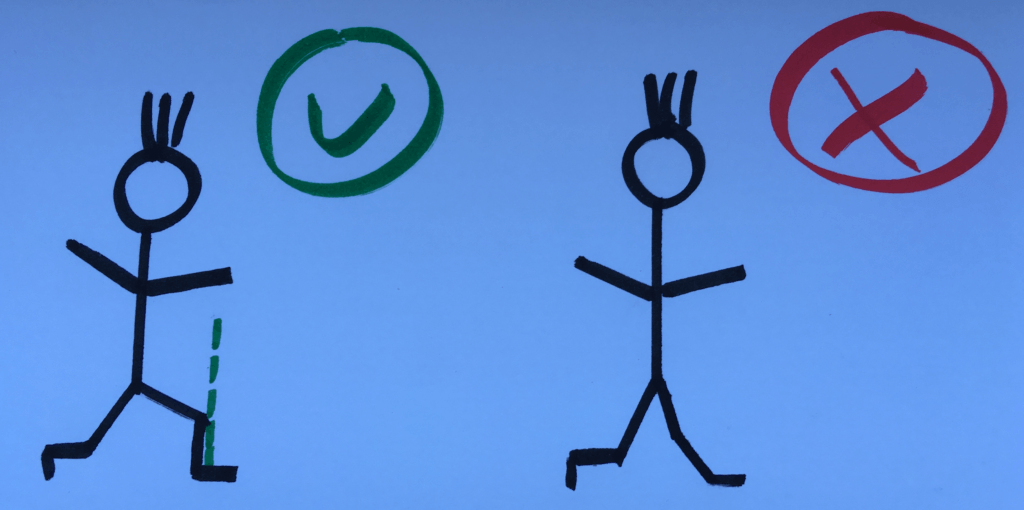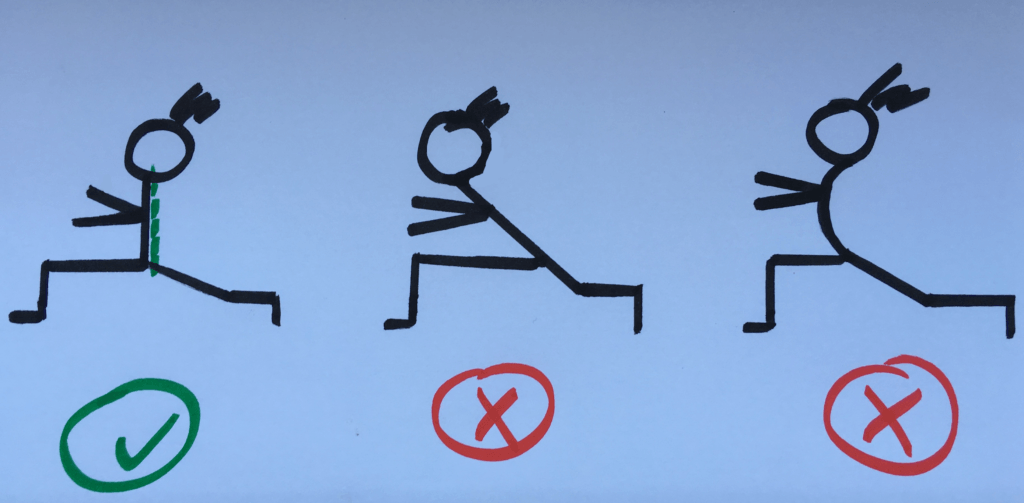A few days ago I promisedyou that we would take a closer look at lunges in the next technique tutorial. Lunges are an integral part of any Bodyattack class and a truly great, whole-body, functional exercise.
How is the whole body involved?
During a lunge, the legs, especially our thighs, work first and foremost. But in reality we have to activate many more muscles of our body and train them at the same time – this makes the lunge a particularly intensive and very strenuous exercise. We train
- the calves,
- the thighs and the booty,
- the hip and abdominal muscles,
- the (upper) back and the shoulder girdle.
Not bad, is it?
In order to perform lunges correctly – and thus effectively and healthily – we have to pay attention to a few things:
- Both feet are straight, with the toes pointing forwards, and are not rotated, because this would automatically create a rotation in the hip and we want to avoid that. The belly button and hip also remain square at all times. This also means that the heel of the rear foot remains lifted.
- The front knee always remains above the middle of the foot when viewed from the front, so your front shin goes straight up and the kneecap points straight forward. Many athletes bend their front knees inwards, which leads to overloading and can lead to long-term injuries. To avoid this, you should actively push the front knee outwards with each lunge (activate the thigh muscles for this).
- Similarly, the back knee also remains in line with the back toe and heel.

- Stay upright – your shoulders should remain over your hips if possible. This distributes your body weight evenly over both legs. I often observe that athletes automatically tilt their upper body forward in the lunge – an evasive movement that takes away its effectiveness. But it’s even worse if you lean backwards – that way you can get into a hollow back posture, which isn’t good for your back at all.
- Pull the shoulder blades down towards the pelvis and towards the middle (towards the spine) – cue: proud chest! -, then you’ll do something for a good posture, too. 🙂

The exact sequence of movements – step by step:
You start in an upright position. The feet are hip-wide, the belly tense, the shoulders low and the chest proud. Now there are two possible movements into the lunge step.
The easier variation – backwards: The easier variation – backwards: Step back – put one foot far back as if you wanted to go to the ground with the corresponding rear knee, but you stop the movement before your knee touches the ground. You land with your back foot on your toes – the heel stays up.
The heavier variant – to the front: Take a big step forward with one foot. The front heel touches the ground first, then the whole foot follows. In this variant, too, the back knee goes very low without touching the ground. The rear heel remains in the air again.
In both cases, be careful not to tilt forward but to stay upright (your shoulders remain over your hips) by continuing to tighten your abdomen and pulling your shoulders low. If you do it right, it almost feels like you’re pushing your hips forward while you are lunging. Your gaze remains straight ahead, your chin remains up – think of the proud warrior in yoga! 🙂
In the end position the front foot stands firmly on the floor and you should reach a 90° angle in the front knee, i.e. the front thigh is parallel to the floor. In the back knee the angle is approx. 135° – the rear thigh is thus inclined diagonally backwards and the back shin is (almost) parallel to the floor. The back heel is in the air, only the toes stand firmly on the ground.
Those who have enough space to move through the room can now do so in the second variant with alternating lunge steps forward. But first of all this only works with the forward variant and secondly we don’t always have enough space to do so. In that case, we either have
the switch on the spot – variant 1: First, the rear leg must step to the front so that both feet stand next to each other again. Activate your abdomen, booty and front thighs and stay upright. Now follows a step back with the other leg as described above. Or
the change on the spot – variant 2: Push up from the front heel so that you can lift the foot and put it back next to the back foot. Make sure you always stay upright without tilting forward and activate your booty and front thighs again before taking a big step forward with your other leg, as described above.
If you have mastered the classic lunge, you are welcome to try the following variations, without changing the technique described above.
- To increase the intensity in strength training: lunges with additional weight – e.g. barbells or dumbbells, a kettlebell or other weights.
- You want to do something for your mobility and stability at the same time? Then in the lunge step raise the elbows laterally to shoulder height (like with “hands up!” 😀 ) and then turn the shoulders and upper body to the side (outwards, thus respectively over the front leg). The belly button and the hip remain straight forward, the twist is in the center of the chest! A tight abdomen helps to maintain balance.
- Pulse Lunges (with or without additional weights): You can hold the lunge and then pulsate several times on the spot – always stay low and make very small up and down movements. By always remaining low, the muscle is permanently strained and by the pulses it is additionally fired up. A great strength endurance workout!
- For advanced players who want to shift the focus away from strength training and towards (high-intensity) cardio training: jumping lunges. The leg change takes place during the jump: Always stay low – it is not about getting high into the air or stretching the legs, but about changing quickly and low. Here it is particularly difficult not to kneel inwards and not to fall forward with your upper body – so stay focused!
Maybe you’ve already noticed that I think lunges are really awesome FIBEEEEER. They are versatile and make us really strong and stable. For me, they belong on every training plan, regardless of goal or orientation (strength or cardio) of the program.
Then subscribe to our blog updates via the sidebar (in the mobile version via the + sign). If you also want to be able to comment on our posts, just register here.

